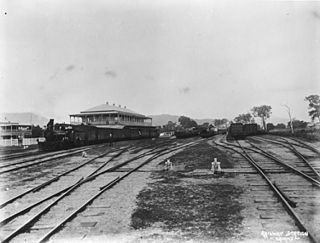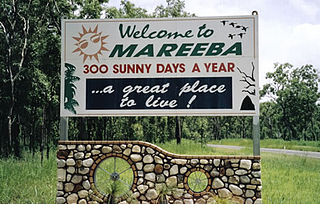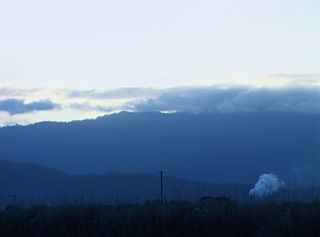
Yungaburra is a town located on the Atherton Tableland in Far North Queensland, Australia, not far from Cairns. In the 2011 census, Yungaburra had a population of 1,116 people.

The Old Butcher's shop is a heritage-listed former butcher shop at 6 North Street, Childers, Bundaberg Region, Queensland, Australia. It was built from c. 1896 to c. 1902. It is also known as HR Lassig butchers, Leatherarts, and Wrench and Thompson butchers. It was added to the Queensland Heritage Register on 21 October 1992.

Hides Hotel is a heritage-listed hotel at 87 Lake Street, Cairns, Cairns Region, Queensland, Australia. It was designed by Sydenham Stanley Oxenham and built in 1928 by Michael Thomas Garvey. It is also known as Hides Cairns Hotel. It was added to the Queensland Heritage Register on 21 October 1992.
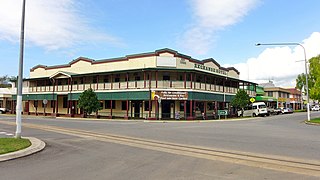
Exchange Hotel is a heritage-listed hotel at 2 Front Street, Mossman, Shire of Douglas, Queensland, Australia. It was designed by Vibert McKirdy Brown and built from 1934 to 1935. It was also known as Daintree Inn. It was added to the Queensland Heritage Register on 9 November 2012.

Barron Valley Hotel is a heritage-listed hotel at 53 Main Street, Atherton, Tablelands Region, Queensland, Australia. It was designed by Hill & Taylor and built from 1940 to 1941. It was added to the Queensland Heritage Register on 5 February 2010.

St James Catholic Church is a heritage-listed Roman Catholic church at Monash Avenue, Malanda, Tablelands Region, Queensland, Australia. It was designed by Bob Hassall and built by Alby Halfpapp from 1925 to 1926. It was added to the Queensland Heritage Register on 28 July 2000. The church is part of the Roman Catholic Parish of Malanda.

Bank of New South Wales is a heritage-listed former bank building at 27 Atherton Road, Yungaburra, Tablelands Region, Queensland, Australia. It was built c. 1914. It was added to the Queensland Heritage Register on 21 October 1992.

St Marks Anglican Church is a heritage-listed church at 7 Eacham Road, Yungaburra, Tablelands Region, Queensland, Australia. It was built in 1912. It is also known as St Marks Church of England. It was added to the Queensland Heritage Register on 21 October 1992.

Cairns Plywood Pty Ltd Sawmill Complex is a heritage-listed sawmill at 25 - 33 Eacham Road, Yungaburra, Tablelands Region, Queensland, Australia. It was built from 1910 to 1980s. It is also known as Cairns Plywood Limited, Eacham Sawmills, and Williamson Brothers Sawmill. It was added to the Queensland Heritage Register on 21 October 1992.

St Patrick's Catholic Church is a heritage-listed church at 1 Penda Street, Yungaburra, Tablelands Region, Queensland, Australia. It was built from 1914 to 1930s. It is also known as Our Lady of Ransom. The church is part of the Roman Catholic Diocese of Cairns. It was added to the Queensland Heritage Register on 21 October 1992.
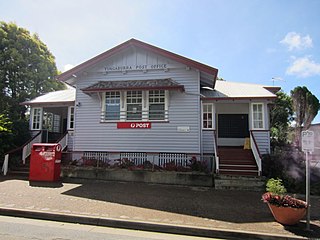
Yungaburra Post Office is a heritage-listed post office at 15-17 Cedar Street, Yungaburra, Tablelands Region, Queensland, Australia. It was built in 1926. It was added to the Queensland Heritage Register on 21 October 1992.

Yungaburra Court House is a heritage-listed courthouse at 6 - 10 Cedar Street, Yungaburra, Tablelands Region, Queensland, Australia. It was built from 1909 to 1921. It is also known as Court of Petty Sessions. It was added to the Queensland Heritage Register on 21 October 1992.

Eden House Restaurant is a heritage-listed detached house at 20 Gillies Highway, Yungaburra, Tablelands Region, Queensland, Australia. It was built c. 1914. It is also known as Nibbles Tea House. It was added to the Queensland Heritage Register on 21 October 1992.

Yungaburra Community Centre is a heritage-listed community hall at 19 Cedar Street, Yungaburra, Tablelands Region, Queensland, Australia. It was built from 1910 to c. 1926. It is also known as Tivoli picture theatre, Williams Estate Hall, and Yungaburra Hall. It was added to the Queensland Heritage Register on 21 October 1992.

Barbers's Shop is a heritage-listed former barber shop at 34 Cedar Street, Yungaburra, Tablelands Region, Queensland, Australia. It was built c. 1925. It was also known as Burra Inn Restaurant and The Workshop. It was added to the Queensland Heritage Register on 21 October 1992.

Allumbah is a heritage-listed detached house at 7 Mulgrave Road, Yungaburra, Tablelands Region, Queensland, Australia. It was built c. 1926. It is also known as Artist's Gallery. It was added to the Queensland Heritage Register on 21 October 1992.

Williams' House is a heritage-listed detached house at 16-20 Cedar Street, Yungaburra, Tablelands Region, Queensland, Australia. It was built from c. 1915 to the 1940s. It was added to the Queensland Heritage Register on 21 October 1992.

7-9 Cedar Street, Yungaburra is a heritage-listed pair of shops at 7-9 Cedar Street, Yungaburra, Tablelands Region, Queensland, Australia. They were built in the 1920s. They were added to the Queensland Heritage Register on 15 March 1996.

Butchers Shop is a heritage-listed butcher shop at 2 Kehoe Place, Yungaburra, Tablelands Region, Queensland, Australia. It was built c. 1922. It was added to the Queensland Heritage Register on 21 October 1992.







